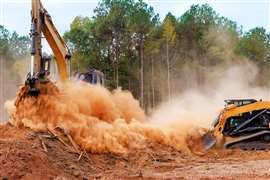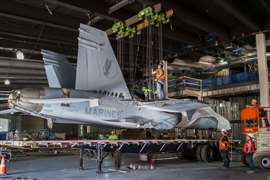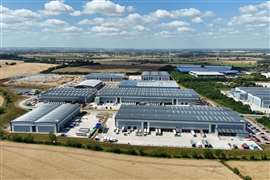Pushing and pulling
24 April 2008

Alook at recent events in the world of trailer-mounts quickly reveals Bil-Jax’s continued strong push into the sector. The Ohio-based company signalled its intent when it secured resources in 2003 to design a whole line, called Summit.
Market entry was with the 13 m working height, telescopic-boomed 3632T, in June 2005. Three articulated models followed earlier this year: the 13 m 3522A, the 15.5 m 4527A, and the 18 m 5533A. All feature fast auto-levelling, a tow speed of 105 kph, and claimed superior size/reach performance.
The company chooses not to reveal sales figures, so firm indicators of market success remain elusive. It does tell AI, however, “we have received a substantial quantity of domestic (US) orders for all the models we are producing.” It also says international enquiries have been arriving.
Extending the line further, the company will release in 2007 10 m and 16 m telescopic models to bracket the 3622T. Both have many of the features of the Summit line, continuing Bil-Jax’s design strategy of “an integrated family providing a high level of parts commonality.”
Coming below its predecessor in the range, the 1250 kg weight 2622T will have 10.1 m of working height, 6.7 m of outreach and a 200 kg cage capacity. At the top of the telescoping models will be the 2450 kg 4642T, which will provide 16.1 m of working height. Its outreach will be 12.8 m with 148 kg of payload and 9.1 m with its 227 kg maximum payload.
Bil-Jax also wants a share of Europe’s market - and others as well. It “targets the completion of CE, CSA, and Australian approvals for our 3632T telescopic model by the end of Q1 2007...and for the full range...by the summer of 2007.” Strongly influenced by sales representation decisions, the company says that it “will more-than-likely be looking to enter the UK market first.”
JLG’s bid for the US market for trailer-mounts, which it describes as “largely untapped” is the Tow-Pro line, the 10.7 m 350 and the 15.2 m 500J, introduced in 2005. In playing its hand, “distribution has been the biggest challenge,“ says director of marketing and business development Dave Baxter. Although the company will not reveal sales figures either, it calls the program “a success,” and Mr Baxter continues, “emerging channels of distribution, such as [hardware superstore chains] Home Depot and Lowes, help us expand beyond traditional rental companies.”
However, compliance with different national road laws, not distribution, is slowing JLG’s push of the equipment into Europe. Although CE certified, the 350 and 500J designs are in a “bit of flux at the moment, we haven’t changed them yet to meet the individual national requirements for road vehicles,” says product manager Ron Jackson.
The company plans to have a unified ’cover’ spec for finish items, such as lights and brakes. Running gear of the European models is different than for the US, and JLG wants to ensure replacement parts are locally sourced.
The company is at the second level of what it calls “homologation” of the line, currently designing to meet individual national requirements while minimising variation. Despite having orders for the machines, JLG has not yet been in a position to ship and is not in a position to say when they will be able to supply machines. The company “is pushing as hard as we can to resolve the matter,” and “hopes for earliest-possible resolution,” says Mr Jackson.
UpRight integration
In the UK, Tanfield Group is absorbing its June acquisition of the powered access part of Irish company UpRight, including moving two factories (see box story). Tanfield has moved the Aerial Access equipment items into the UpRight Powered Access product list. The Aerial K13 trailer is now theTL37 and the K17 is the TL49.
Their working heights as the same as current UpRight models, but the Aerial machines are simpler, heavier, and more robust - characteristics that are attractive in both developing markets and in Australia and the UK, where “we are able to give Nifty a good run for money, ” says Richard Tindale, product and business development manager for the UpRight business.
UpRight “will keep both [Aerial and UpRight models] side-by-side until dealers tell them which they want,” he says. UpRight’s larger dealer network is one reason Tanfield bought it, although “It has taken a bit of effort to resurrect it, but it is going well, smoother than I expected”, says Mr Tindale, adding that the new dealers have placed orders for the TL39 and TL49.
The acquisition activities have delayed the new UpRight trailer mount, a 19 m, ’Scandinavian’ type machine. It exists as prototype but won’t be released till mid-2007, says Mr Tindale. He anticipates a family of this type machine, beginning with a riser and jib boom for the 19 m, in a configuration yet to be determined, followed probably by a 23 m model.
Elsewhere in the UK is Niftylift, whose most recent addition to its six-model trailer-mount range is the 1750 kg, 225 kg capacity, 14.7 m working height model 150, launched at Access Daze in May. It has fully proportional hydraulic controls, traction drive, and a retracting axle. Its telescoping outer boom provides 7.53 m of outreach, and it has up-and-over clearance of 5.6 m.
Not successful in the UK has been Ateco International, which sold into South Africa, Germany and The Netherlands. It has “stopped making [trailered] machines at the moment; business is down,” says managing director John Cassell. “The UK market dropped off. It became too competitive.”
Getting onto European roads in late November will be a new model from Omme Lift AS, says managing director Harry Lorentsen, although that is all he would tell AI about it. The new machine will have missed the company’s celebration of its 100th anniversary a few months ago, but it is expected to help maintain into 2007 the 30% turnover rises the Danish company has enjoyed for the past three years.
Outrigger widths
Outrigger positioning is what most differentiates Germany’s latest rollout, the Teupen Gepard 25 T Rent, released in May. The 3130 kg 25 m working height machine’s legs deploy to three different widths - 4.65 m at the widest - to maximise site access flexibility. They also automatically level the machine on slopes up to 23°.
When set up, the 25 T reaches laterally to 12.5 m with a 200 kg payload and to 15.5 m with 80 kg. It tows at 80 kph, and all functions can be controlled from the basket.
Finland’s Dino Lift has been busy trying to meet increased demand for its products and has been investing in production facilities. The company launched the 26 m 260XTD, a drive-from-the-basket model, at last year’s APEX exhibition, but would not give details of any planned launches.
The company has, however, developed a tarpaulin cover for the model - as previously reported in AI - and also reached a notable landmark by producing its 5000th machine. This machine has been sold to Dino’s German dealer, Hematec, who exhibited it at the Platformers Days show in August.
Worldlift Industries in Denmark is planning for an early 2007 release of a 200 kg basket payload version of its 12 m working height, 985 kg Denka Junior 12 model. “Some of our users for safety reasons want two men in the basket,” Worldlift’s managing director, Ernst Fuller, explained to AI.
Continuing to put the 30-some units of its annual production on the road in France, The Netherlands, and its home country is Belgian manufacturer Thomas. It tells AI that it has no plans for new models. Likewise Genie Industries, which told Access International that it has no plans to change its TZ-50 and TZ-34/20 models.
On the other side of the world, rental customers’ experiences on the wide spaces and on rough roads of Australia have led the New Zealand subsidiary of Snorkel to modify its 12.5 m working height MHP 13/35 and the 15 m 15/44 trailer models, of which it has shipped about 200 units during the past year. They now come with heavy-duty leaf spring axles. This “style is more durable, particularly for our country customers,” says Snorkel sales manger Dave Kane. If it works in the Outback it’s likely to work pretty much anywhere in the world.




